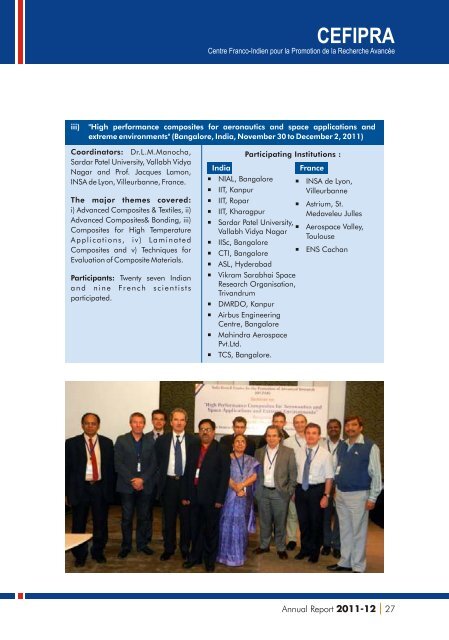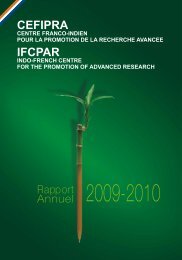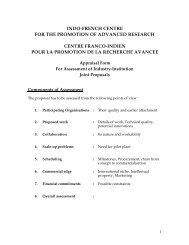IFCPAR AR (ENGLISH) for CD - CEFIPRA
IFCPAR AR (ENGLISH) for CD - CEFIPRA
IFCPAR AR (ENGLISH) for CD - CEFIPRA
You also want an ePaper? Increase the reach of your titles
YUMPU automatically turns print PDFs into web optimized ePapers that Google loves.
<strong>CEFIPRA</strong><br />
Centre Franco-Indien pour la Promotion de la Recherche Avancée<br />
Duration: Three years (January, 2008 to December, 2010)<br />
Objectives<br />
The objective of this project was to selectively reduce nitrate in water<br />
into nitrogen by totally avoiding the <strong>for</strong>mation of ammonium ion, an<br />
undesirable product. Two routes were to be compared: the catalytic<br />
and the electrocatalytic ones. The specific objectives were:<br />
i) Preparation of Palladium/tin catalysts and characterization by<br />
various surface analytical techniques ii) Determination of activity<br />
and selectivity <strong>for</strong> nitrate removal by catalysis and electrocatalysis.<br />
iii) Evaluation of the catalytic reduction of nitrate in water by varying<br />
different parameters such as the pH, the hydrogen partial pressure,<br />
and the temperature. iv) Examination of the electrocatalytic<br />
reduction of nitrate in water by fast sweep cyclic voltammetry, square<br />
wave voltammetry, amperometry, rotating ring disc electrode and<br />
steady state polarisation technique. v) Comparison of the two<br />
techniques (catalytic and electrocatalytic) in the same conditions and<br />
on the same catalysts to gain a better understanding of the reaction<br />
mechanism.<br />
Accomplishments<br />
i) Highest active and selective catalysts PdSn/Al O and PdSn/TiO<br />
2 3 2<br />
were prepared<br />
ii) Superior nano-electrocatalysts PdSn/Ti and PdAg/Ti were<br />
–<br />
developed <strong>for</strong> the direct electrochemical reduction of NO to N<br />
3 2<br />
iii. Developed a 25A (1.5L/hr) capacity electrochemical nitrate<br />
removal unit to treat 1000ppm of nitrate contaminated water<br />
iv. Additionally, an electrocoagulation process (0.5L/hr) was<br />
developed <strong>for</strong> nitrate removal without intermediates<br />
v. Filed a joint patent in India and PCT<br />
Research papers published: Two<br />
Patent filed : One<br />
Experimental setup<br />
Research Activities 2010-11<br />
Other Priority Areas - Water<br />
Project 3800-W1<br />
ENHANCED PROCESSES FOR THE REMOVAL OF NITRATE FROM WATER<br />
Dr. S. Vasudevan<br />
Electro Inorganic Chemicals Division<br />
Central Electrochemical Research<br />
Institute (CSIR)<br />
Karaikudi<br />
Dr. Florence Epron<br />
Laboratoire de Catalyse en Chimie<br />
Organique, UMR6503 CNRS<br />
Université de Poitiers<br />
Poitiers<br />
27





